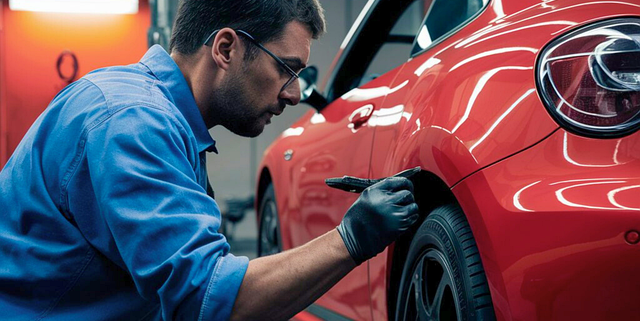Tire Maintenance: Checking Pressure & Tread for Safety
Tire inspections are essential for ensuring road safety, vehicle performance, and cost-effectiveness. Whether you’re a used car shopper evaluating a potential purchase or a driver maintaining your current vehicle, regularly checking tire pressure and tread depth can help prevent accidents, extend tire life, and optimize fuel efficiency.
This guide will cover:
- How to test tire pressure to ensure optimal performance and safety.
- How to check tire tread to determine how much life remains in your tires.
- Signs of tire wear and when to consider replacing your tires.
How to Check Tire Pressure
Why Proper Tire Pressure is Important
Maintaining the correct tire pressure prevents uneven wear, improves fuel efficiency, and enhances vehicle stability. Underinflated tires create excessive friction, causing overheating and premature wear, while overinflated tires lead to poor traction and uneven wear patterns.
Tools Needed
- Tire pressure gauge (digital, dial, or stick-type)
- Air compressor (for inflating tires)
- Manufacturer’s recommended PSI (found in the owner’s manual or on the driver’s door sticker)
Step-by-Step Guide to Checking Tire Pressure
- Park on a Level Surface – Ensures accurate readings.
- Check Pressure When Tires Are Cold – Measure before driving to avoid heat expansion inaccuracies.
- Locate the Valve Stem – Unscrew the cap.
- Attach the Gauge – Press firmly to get a reading.
- Compare with the Recommended PSI – Adjust pressure if necessary.
- Inflate or Deflate as Needed – Use an air compressor to add air or release air if overinflated.
- Recheck Pressure and Replace the Cap – Ensures a secure seal.
Risks of Incorrect Tire Pressure
- Underinflated Tires: Excess friction, overheating, increased wear, and possible blowouts.
- Overinflated Tires: Reduced grip, increased tread wear in the center, and higher risk of slipping on wet surfaces.
Always follow the manufacturer’s recommendation rather than the maximum PSI printed on the tire’s sidewall.
How to Check Tire Tread
Why Tire Tread Matters
Tire tread plays a crucial role in grip and traction, especially in wet or icy conditions. Worn-out tires increase the risk of hydroplaning, reduce braking efficiency, and compromise handling. If you’re buying a used car, checking the tread depth helps you assess potential upcoming expenses.
Tools for Measuring Tread Depth
- Tread depth gauge – A precise tool available at hardware and auto parts stores.
- The toonie test (Canada) or penny test (U.S.) – Quick alternatives using common coins.
- Built-in tread wear indicators – Raised sections in the grooves of your tire that indicate when replacement is needed.
Full Tire Inspection: Signs of Wear and When to Replace
Signs of Uneven Tire Wear
- Worn edges – Indicates underinflation.
- Worn center – Indicates overinflation.
- Cupping or dips – Suggests worn suspension parts.
- Sawtooth edges – Points to misalignment.
When to Replace Your Tires
- Tread depth is at 4/32” or lower.
- Tires show visible cracks, bulges, or punctures.
- Your car has decreased traction, especially in wet conditions.
- Your tires are more than 6 years old (even if they look fine).
Conclusion
Regular tire inspections help ensure your vehicle remains safe and efficient. By routinely checking tire pressure and tread depth, you can prevent costly repairs, improve fuel economy, and extend the lifespan of your tires. Whether you’re a car owner or a used car buyer, making tire maintenance a habit can lead to a smoother and safer driving experience.

